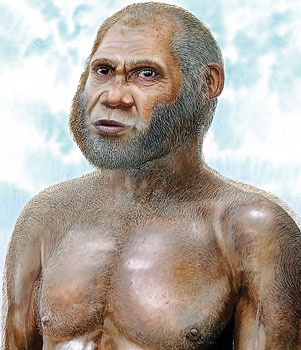Four Stone Age people found in caves in China could be a entirely new species of humanoid - and the discovery 'opens a new chapter' in the history of evolution, say archaeologists.
The fossils, found in two caves, belong to a previously unknown Stone Age people and have a 'highly unusual' mixture of ancient and modern features.
 |
| Four mystery cavemen dug up in China could be a new species of humanoid. The fossils belong to a previously unknown Stone Age people |
Named the 'Red Deer people' because of the animals they hunted and dating from between 14,500 to 11,500 years ago, they are the youngest humanoid fossils to be found in Asia.
Previously it had been thought that early humans had little competition in the continent.
The 'Red Deer' discovery has 'startling implications for the early peopling of Asia', said Professor Curnoe, of the University of New South Wales.
They would have shared the land with modern looking humans at a time when China's earliest farming culture was beginning, he said.
Writing in journal PLoS One, Prof Curnoe explained: 'These new fossils might be of a previously unknown species, one that survived until the very end of the Ice Age around 11,000 years ago.
He said: 'The discovery of the red-deer people opens the next chapter in the human evolutionary story - the Asian chapter - and it's a story that's just beginning to be told.'
'Alternatively, they might represent a very early and previously unknown migration of modern humans out of Africa, a population who may not have contributed genetically to living people.'
Three sets of remains were found at Maludong - Red Deer Cave' - in the Yunnan province in 1989. They were unstudied until 2008.
A fourth was found in 1979 a cave near the village on Lonling in neighbouring Guangxi Zhuang province. It was encased in rock until 2009.
The skulls and teeth from both finds are very similar to each other and show an unusual mixture of archaic and modern anatomical features, as well as previously unseen characteristics.
Scientists have named them 'red deer people' because evidence suggests that they hunted extinct red deer and cooked them in the Maludong cave.
Until the discovery, no fossils younger than 100,000 years old had been found in mainland east Asia other than those of our own species, Homo sapiens.
This suggested that Homo sapiens had the run of the area which was devoid of our evolutionary ancestors once the first humans appeared.
But the new find suggests this may not have been the case.
Professor Ji Xueping, of the Yunnan Institute of Cultural Relics and Archeology, said: 'Because of the geographical diversity caused by the Qinghai-Tibet plateau, south-west China is well known as a biodiversity hotspot and for its great cultural diversity.
'That diversity extends well back in time.'
In the last ten years scientists have discovered the enigmatic 'Hobbit' fossil in Asia as well as evidence modern humans interbred with ancient Denisovans, a species from Siberia.
The latest find shows there is more to learn from the continent, said Prof Curnoe.
© Daily Mail, London |


